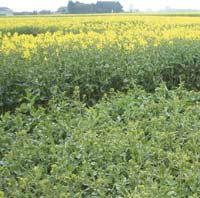Crop Watch: Weather could damage yield

Prolonged cold and wet weather could reduce yields, say our Farmers Weekly Crop Watch agronomists.
In Yorkshire, late-drilled crops had been hit particularly hard, said AICC agronomist Patrick Stephenson. “In my opinion, yield will already be affected.” And with more cold and wet weather forecast forward crops were also likely to suffer, he said. “This is due to the inability to apply trace elements, herbicides and fungicides either because of the ground conditions or weather.”
Spring planting hadn’t started and growers should consider leaving ground fallow rather than struggling to establish a crop, he suggested. “The current outlook for spring barley is so bleak that fallow is certainly a better option on some farms.”
In the east, soil structure had been damaged on ground after late-lifted sugar beet, said Frontier agronomist Brian Ross from Suffolk. He was also advising growers in this situation to consider leaving some fields uncropped this spring.
“Planting a cover crop such as mustard will help improve soil condition by sucking up moisture and will count toward the Campaign for the Farmed Environment.“
Pigeon damage had reduced leaf cover on oilseed rape and nitrogen would have to be applied earlier and at higher rates on struggling stands, he said. These crops would also respond to increased sulphur doses, he added. “The first nitrogen and sulphur application should go on when soil temperatures reach 5C or growth starts.”
ProCam agronomist Nick Brown from Buckinghamshire was concerned about delayed Atlantis and Pacifica (both mesosulfuron + iodosulfuron) applications. “If blackgrass application are not applied before T0 then we will have major tank mix problems.”
High blackgrass populations should be treated with Pacifica rather than Atlantis, he said. “Its higher active ingredient loading provides higher levels of control.”
Choosing the optimum nozzle, boom height and forward speed would help maximise efficacy, he noted. “Avoid air inclusion nozzles, speeds above 12kph and keep the boom height to around 60cm above the crop.” Increasing water volumes to 150-200l/ha would also help, he added.
In Shropshire, some cereal crops on lighter land were suffering from manganese deficiency, said AICC agronomist Bryce Rham. “I think frost lift is partly to blame and will apply manganese at the first opportunity.”
If conditions allowed, low rates of nitrogen and sulphur would be applied to later-sown and backward oilseed rape this week, he said. “We’ll also have a go at applying remaining graminicides and fungicides.”
Later-sown wheat crops that missed their autumn herbicide had been kept clean by the cold weather and application of spring products would be delayed for at least a fortnight, he said.

